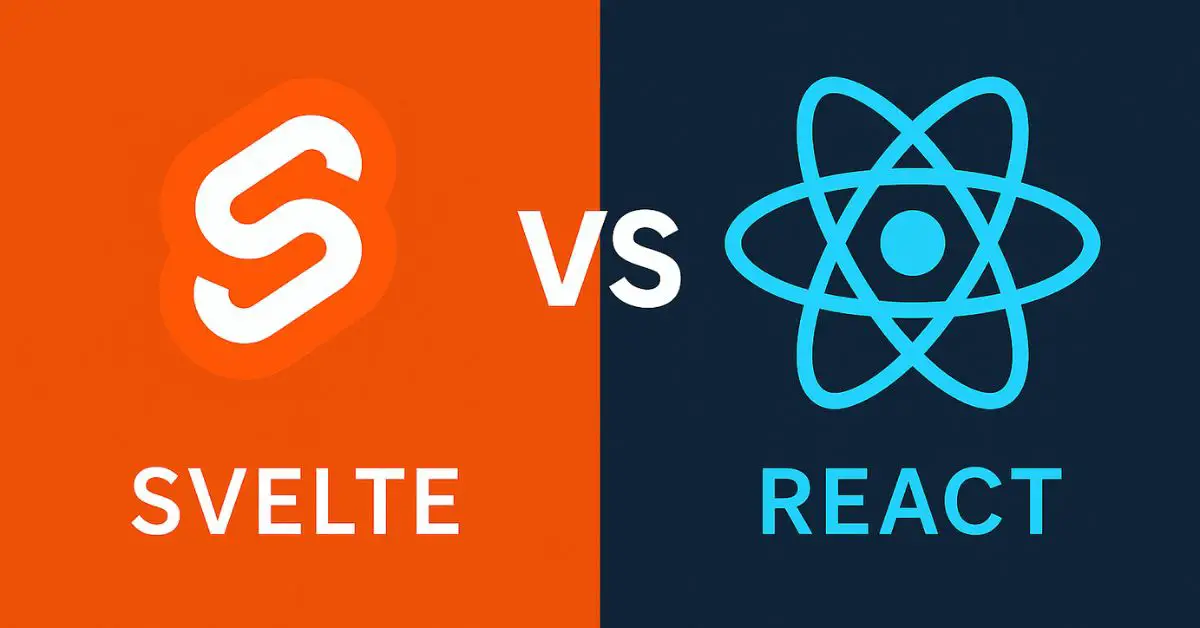Choosing the right frontend framework can profoundly impact your product's performance, developer productivity, and hiring strategy. React is still one of the dominant players in the JavaScript ecosystem, while Svelte is a newer contender that's been gaining traction for its radical compiler-based approach. In this post, I share a deep analysis of Svelte vs React across core architecture, performance benchmarks, developer experience, ecosystem maturity, and even hiring considerations. I will use the latest 2024/2025 insights, releases, trends, use cases, and job market data to help you decide which technology aligns best with your project and business priorities.
What is React?
React is the most popular open-source JavaScript library (often called ReactJS) for building user interfaces, developed by Meta. It lets developers build complex UIs by combining reusable pieces of UI. Like Lego bricks for the frontend. The main feature of React is flexibility. It gives you just enough to build your UI layer and lets you choose how to handle everything else — routing, data fetching, state management, and more.
React is used by 40% of developers worldwide. React is one of the main characters in the world of frontend development.
Key Features of React:
- Virtual DOM: React uses a virtual DOM as a smart draft layer. It updates a lightweight copy of the UI, compares it to the previous version, and then applies only the necessary changes to the real DOM, saving time and keeping things fast.
- JSX (JavaScript XML): JSX is a syntax that lets developers write HTML-like code directly inside their JavaScript.
- One-Way Data Binding: In React, data flows from parent components down to child components. This is called one-way data binding, an architectural advantage, especially in large-scale applications.
- Comfortable Scalability: React gives teams the freedom to structure applications the way they need, whether that's a quick MVP or a complex enterprise system.
What can you build with React?
Almost anything with a user interface. Teams around the world use React to create:
- Web Applications – From lightweight MVPs to enterprise-grade dashboards, CRMs, SaaS platforms, and admin panels.
- Marketing Websites – Fast, SEO-friendly static or server-rendered sites using frameworks like Next.js.
- E-commerce platforms with dynamic product listings, shopping carts, filters, and user authentication.
- Cross-platform mobile apps using React Native, allowing you to reuse logic and components across iOS and Android.
- Content-rich websites and blogs use frameworks like Next.js for static generation, server-side rendering, and SEO optimization.
What is Svelte?
Svelte is a modern JavaScript framework for building user interfaces — but unlike React, it doesn't use a virtual DOM or run in the browser as a framework. Instead, Svelte is a compiler: it takes your components and turns them into highly optimized JavaScript at build time.
Svelte is often compared to React because they serve the same purpose — building interactive UIs with reusable components — but they take very different approaches.
Key Features of Svelte:
- Direct DOM Updates: Unlike React, Svelte doesn't need to diff and reconcile a virtual DOM. It generates precise, minimal code that updates the real DOM directly, resulting in faster and smaller apps.
- Minimal Boilerplate: Svelte apps require less code to achieve the same results. You can build dynamic interfaces with fewer lines, no wrappers, and little configuration — speeding up development.
- Easy syntax: Svelte offers easy-to-learn syntax, making it a beginner-friendly framework.
- Built-in transitions and animations: Svelte has built-in support for smooth transitions and animations, making it easy to add interactive elements to your website or application.
What Can You Build with Svelte?
Fast, lightweight, and highly interactive interfaces. Teams use Svelte to power:
- Web Applications – MVPs to full-featured dashboards, CRMs, SaaS tools, and admin panels — all with minimal overhead and maximum performance.
- Marketing Websites – SEO-friendly static or server-rendered sites using SvelteKit, built to load fast and rank well.
- E-commerce frontends with smooth product filtering, cart interactions, and minimal bundle sizes for faster conversions.
- Interactive widgets and animations for embedding dynamic, lightweight components into any page — from quizzes to charts to media-rich stories.
- Internal business tools and admin panels that are easy to build, maintain, and scale with Svelte's simple reactivity and component model.

React vs Svelte: 3 Core Differences
Now that we've explored the key features of both React and Svelte, let's dive into a head-to-head comparison to help you make an informed decision.
React vs Svelte: Performance
When it comes to performance, both React and Svelte can deliver fast, responsive interfaces, but their approaches have differences in certain metrics.
Bundle Size & Load Time: Svelte's biggest performance win is often at application startup. For example, the core Svelte runtime is about 1.6 KB versus React+ReactDOM's ~44 KB. In practice, a Svelte app's First Contentful Paint tends to occur sooner than React's on equivalent projects, especially on slower networks or devices.
DOM Update Efficiency: React uses the virtual DOM to minimize costly DOM operations – updating the real DOM only after computing differences. Svelte avoids diffing entirely. It knows what needs to change when the state updates. In many benchmark tests, Svelte performs DOM updates faster and with less memory overhead.
Interactive Performance: Both frameworks aim for quick Time to Interactive – how soon a user can actually interact after page load. Because Svelte's startup cost is lower, it often reaches interactivity faster for small-to-medium apps.
React vs Svelte: Developer Experience and Learning Curve
One of the most significant differences between React and Svelte is the developer experience.
Syntax and Learning Curve: Developers report that Svelte feels more intuitive than React, which can sometimes feel like "JavaScript plus a new dialect (JSX) plus a framework-specific runtime" to learn.
Developer Enjoyment: Many developers find Svelte "fun" and refreshing to use – its philosophy, "write less code, do more," and immediate reactivity can make development feel simpler and more direct.
React vs Svelte: Community, Popularity, and Adoption
The next crucial difference is how many people use it, how many developers talk about it, and how many solutions people share on the web.
Usage and Popularity: By sheer numbers, React is still the most used frontend framework globally. One analysis of 250,000 job listings in 2024 found React mentioned in about 52% of frontend roles. However, popularity trends show Svelte growing rapidly. Svelte's GitHub repository stars jumped from ~32k in 2019 to ~56k in 2023 and climbed beyond 60k by 2025, reflecting rising developer interest.
Hiring and Talent Pool: Hiring React devs is easier in the sense of availability, but you'll also be competing with many other companies for the same talent. Svelte's community support, while good, requires more interaction, like asking questions in the community chats or GitHub.
Ecosystem and Third-Party Libraries
React has been around since 2013 and has achieved mass adoption. As a result, it has a rich ecosystem with countless solutions available. Svelte's newer and its philosophy reduces the need for certain libraries.
When to Use React?
In 9 out of 10 cases, React is the right choice. It is mature, flexible, and supported by a massive ecosystem. Choose React if:
- You're building a large-scale application or platform.
- You need a mature ecosystem or specific integrations.
- Team size and hiring matter.
- You want long-term support and low risk.
- Cross-platform reach is on your roadmap.
- You need robust SEO and SSR capabilities.
When to Use Svelte?
Use Svelte when:
- You want lean, fast, highly-performant apps.
- You're building a lightweight app, MVP, or prototype.
- Developer experience and team velocity matter.
- You're working with a small team or solo.
- You need highly interactive UIs or animations.
- You want a modern stack with minimal overhead.
Examples:
- React: Facebook, Airbnb, Netflix, Uber, Atlassian.
- Svelte: The New York Times, Spotify, Netflix components, Apple Podcasts, Square Enix.
- Stack Overflow Developer Survey 2023
- GitHub Repository Statistics, 2025
- Frontend Framework Job Market Analysis, 2024
- React Official Documentation
- Svelte Official Documentation
Arsalan Malik is a passionate Software Engineer and the Founder of Makemychance.com. A proud CDAC-qualified developer, Arsalan specializes in full-stack web development, with expertise in technologies like Node.js, PHP, WordPress, React, and modern CSS frameworks.
He actively shares his knowledge and insights with the developer community on platforms like Dev.to and engages with professionals worldwide through LinkedIn.
Arsalan believes in building real-world projects that not only solve problems but also educate and empower users. His mission is to make technology simple, accessible, and impactful for everyone.



